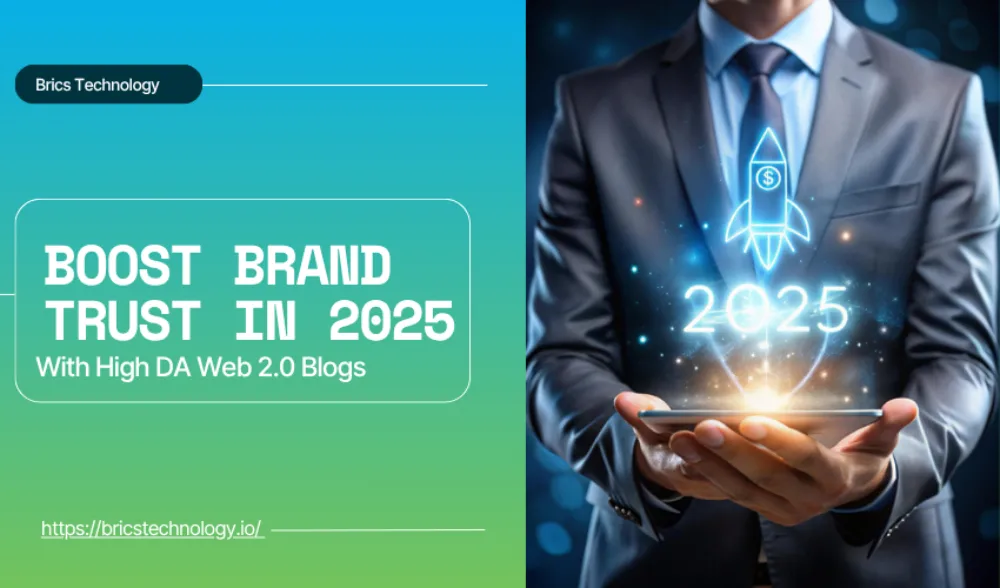Boost Brand Trust in 2025 with High DA Web 2.0 Blogs

Struggling to build brand trust while competing with thousands of similar voices online? Most brands rely solely on social media or best white label facebook ads – only to face declining engagement and skepticism. Without credible third-party validation, even the best offers get ignored. Fortunately, High DA Web 2.0 blogs offer a low-cost, high-authority solution to strengthen trust, boost visibility, and establish long-term brand credibility. This article breaks down exactly how to do it right in 2025.
The Evolution of Brand Trust & Web 2.0 Blogging
Changing Trust Signals in 2025
- Transparency and authenticity now matter more than ever: real user reviews, detailed author bios, and brands that openly show their expertise rise to the top.
- Google’s focus on E-E-A-T (Experience, Expertise, Authoritativeness, Trustworthiness) now emphasizes real author credentials and content genuineness for high ranking.
- AI-detection algorithms and stronger authenticity metrics from Google mean spin, fluff, and shallow content simply won’t pass.
Why SEO-Centric Web 2.0 Needs a Brand-First Pivot

Gone are the days when prolific submission on any Web 2.0 platform meant safe, easy SEO wins. In 2025, Google rewards true brand signals: author transparency, high-quality writing, organic links, and visible engagement—all of which turn generic Web 2.0 posts into trust amplifiers.
Benchmarking Brand Authority with Leading Web 2.0 Platforms
| Platform | Authority Boost | Trust Factors | Ideal Use Case |
| WordPress.com | High DA, extensive branding | Full profiles, author bio | Thought leadership, backlinking |
| Medium | Built-in audience, followers | Niche trust, expert tone | Personal brand stories, case studies |
| Wix/Weebly Blogs | Visual & content flexibility | Branding visuals, UX | SMBs, product trust |
| Blogger | Google-owned, basic tools | Easy to use, reliable | Beginners, general authority |
Pro-Tip: Combine 2-3 platforms for every campaign to maximize reach and audience trust while diversifying your backlink profile.
Core Web 2.0 Content Models Driving Trust in 2025
Your approach to Web 2.0 backlinks must balance publishing efficiency and authenticity. Here are three proven models that build trust effectively:
- Thought Leadership Posts: Long-form, unique content that shares brand stories, personal insights, or detailed analysis. This boosts topical authority but requires time and first-hand experience to create.
- Branded Mini-Sites: Interlinked portfolios or niche blogs that showcase a consistent brand voice. These strengthen multi-channel presence but must avoid duplicate content penalties.
- Curated Community Blogs: Publishing on popular community-driven platforms like Medium allows immediate trust transfer due to existing audiences but limits link control
A blend of thought leadership, mini-sites, and community blogging maximizes both user value and platform authority.
What Actually Drives Web 2.0 Trust in 2025?
- Content authenticity: Real, human stories, SEO insight, and professional experience stand out.
- Profile transparency: Full author names, verified emails, and visible brand connections foster instant trust.
- Value-first writing: Solving user problems and offering actionable guidance, not just keyword stuffing.
- Strong visual identity: Logos, author photos, and custom visuals signal real business presence.
- Post engagement: Comment sections, shares, and “claps” all boost perceived authority.
Web 2.0: From Spammy Backlinks to Brand-Building Powerhouse

- AI-detection tools favor genuine, authored content over spun articles.
- Google’s trust-centric indexing elevates original, expertise-rich posts.
- Using a multi-channel stack (Medium, WordPress.com, Substack) is better than focusing on a single platform.
- Depth and relevance: A handful of strong, broad-audience Web 2.0 posts deliver more authority than 50 shallow, spammy ones.
Key 2025 Web 2.0 Platforms for High DA Backlinks
| Platform | Starting Cost | Trust Score* | DA | Key Features | Best For |
| Medium | Free | 9.2/10 | 95 | Inbuilt audience | Stories, guides, B2B insights |
| WordPress.com | Free/Paid | 9/10 | 92 | Plugins, customization | Expert blogs, business updates |
| Blogger | Free | 7.5/10 | 91 | Google-owned, simple | Getting started, general posts |
| Wix | Free | 8.5/10 | 91 | Visual/designer edge | SMB product, service brands |
*Trust Score is based on reputation, engagement, and content flexibility.
Deep-Dive: CitationBuilderPro’s Trust-Boosting Blueprint
- Verified profiles & author bios for every Web 2.0 site deployed.
- Unified brand voice maintained in all posts and profiles.
- Every backlink is contextualized (placed naturally within insightful advice or stories).
- Diversification across a minimum of five unique high DA domains for every campaign.
CitationBuilderPro stands out by prioritizing holistic, white-hat authority building over mere volume, making it a trusted choice for businesses using white label website builders.
Best Practices for Publishing and Linking (Without Losing Trust)
- Use branded anchors and phrases; avoid forced or exact match keywords.
- Integrate links contextually so they serve the user, not just the algorithm.
- Never stuff links, and steer clear of obvious SEO “footprints.”
- Stick to a consistent monthly publishing cadence to foster regular audience engagement and develop authority.
- Routinely audit your content for freshness; outdated or irrelevant blogs undermine your brand’s authority.
Future-Proofing: Scaling Web 2.0 for Brand Trust
- Team training: Educate freelance writers and in-house teams about brand safety, guidelines, and E-E-A-T principles.
- Responsible AI use: Only use AI for idea inspiration, outlines, or proofreading. All final draft writing and editing should be manual for maximum authenticity.
- Monitor trust KPIs: Dwell time, brand mentions, social shares, and referral traffic reveal the real impact of trust-driven publishing.
- Stay updated: Set aside monthly review cycles – dormant or stale Web 2.0 profiles harm trust quickly.
Expert FAQs: Your Top Web 2.0 Backlink Questions – 2025
Q1: Are Web 2.0 sites still valuable in 2025?
Ans : Absolutely! But only if the content is unique, experience-based, and focused on building brand trust. Thin, generic, or spun content has no place in modern Web 2.0 strategies.
Q2: Which matters more—backlinks or audience building?
Ans : Both are vital. Trust and authority drive natural backlink growth and engaged, referral-rich audiences over time.
Q3: How do I measure if my Web 2.0 strategy is working?
Ans : Track metrics like referral traffic, engagement (shares, comments, dwell time), and increases in branded keyword searches.
Q4: Should I automate my Web 2.0 posting?
Ans : No—while AI can help brainstorm, you must manually craft and edit all final posts for trustworthy results and E-E-A-T compliance.
Q5: How many Web 2.0 posts should I create monthly?
Ans : Aim for 3–5 substantial, high-quality posts per month, spread over 2–3 platforms to build robust, lasting authority.
Catagories
Recent Post
- Tired of Disconnected Systems? How Cloud Telephony + CRM Improves Efficiency
- Stealthly AI: Transforming AI Content into Authentic Human Text
- Why Weighted Grade Calculators Matter for Accurate Academic Planning
- Customize Your Phone Sound with a Free Online Ringtone Maker
- How to Use AI in Stock Trading for Smarter Decisions
